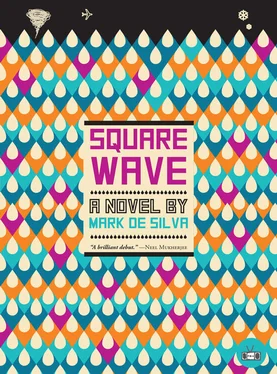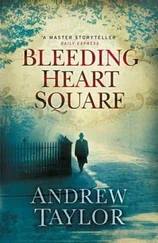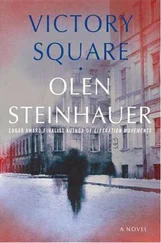The rocket stage of the final missile fell to earth as the six darts parted ways. They fanned out in smooth parabolic arcs until they ran parallel to the cloud base, just beneath its surface, and it was only their color, a sharp yellow from the smoldering antimony, that made their slender contrails visible against the grayscale backdrop of clouds.
A star like an asterisk formed as the darts diverged from the origin at speed. The contrails grew pale, their color thinned by cloud as the darts sliced through the gauzy base, burrowing further by the second. The lines gave out and the star peaked when the darts were too deep to see.
“Eighteen darts make three stars,” Menar said. “The other two, at the higher elevations, we can’t see, but they’re there. And that’s it.” He scrolled through the onscreen values, the mathematical trace of the darts.
“This is the definition of a warm-water cloud,” he said. “It must be a hundred degrees today, and without the sun. If there are any supercooled droplets at all in that cloud, there aren’t many.”
Menar went outside and the others followed.
“The darts run very hot,” Menar said, “creating tiny updrafts. The antimony particulate is taken up in them, you get greater diffusion. That’s the root of natural condensation. Then the binding of particulate with water microdroplets, the coalescence threshold drops, and the microdroplets suddenly turn macro. No simulation of ice crystal nuclei at all,” he trailed off. “That would be pointless in a cloud like this, it’s so warm. There’s nothing to crystallize.” Menar turned and said, “You can send the drone through again, Michael, and see the difference we’ve made already.”
Michael had kept the tiny unmanned plane in a holding pattern nearby, continuously recording data with a battery of sensors for other experiments carried out earlier in the day, but ready for use should they need it here. He made a call to the pilot and in a few moments it cut through the cloud like a larger dart, a desert tan to the dart’s reflective copper, flying upward until it emerged from the top. “Temperatures are up and rising,” Michael confirmed as he joined the others outside. The cloud thickened and yellowed, the bottom edge darkened, the black bands widened.
“You know, we do use — Ravan has probably told you — a propagation approach sometimes,” Menar said. “Identify a pocket of supercooled droplets, get it to overtake the rest of the cloud, freeze the whole thing. We’ve also tried creating that pocket ourselves, if we can’t find one. Nitrogen flares—”
Just then Michael’s eyes disappeared behind a splatter of water. He pulled the glasses from his face with a startled grin and grabbed Menar’s shoulder.
“Well then,” Menar said. “We should probably go back inside. These artificial rains can be monstrous.”
The drops were sharply formed and proportioned to a monsoon. They burst on the skin like tiny balloons, and the water released felt almost sticky. There was an uncommon discreteness to the downpour. It produced the sort of precisely articulated patter on the mudflats, like a continuous drumming of the fingers, one might expect from a much harder, more resonant surface, like the aluminum roofing of the station (though the earth had more bass to it).
The saucers started to come apart. Fissures appeared and filled with water that overflowed the cracks running like grout lines between the mud tiles. The crisp attack of the rain slowly gave way to a gurgling.
Menar leaned up against the steel table with his hands wrapped around its edge.
“Well,” Ravan said softly, sitting down at the terminal directly behind the table. The storm had transfixed the NOAA men, holding them where they were.
“Yes, well,” Menar said. “If you hadn’t seen this before, you’d be just as stunned as they are.”
As the storm swelled, the raindrops lost their form and merged into ropes. The saucers were invisible now beneath a roiled, viscous layer of water, the rain falling faster than the ground could take it in.
“This is striking, Menar, really striking. Especially with warm water,” Michael said, turning away from the storm to face him. Water ran into the station in thick rivulets, amplifying the brightness of the corrugated steel floor.
“But I am starting to worry this could become a flood,” he continued. “We should close these doors or—”
“Well if you’ve seen enough, let’s switch it off,” Menar said. “As I say, we’ve never dispersed a cloud we’ve provoked into storming, certainly not like this. I do wonder if the two agents will interact in some way. They shouldn’t. But let’s see. Close the doors, I think. The monitor will serve.”
The techs brought the door back down, muting the falling water. Menar re-adjusted the position of the eastern platform, five degrees to the west. The seeders were identical to the dispersers in appearance, save for the darts, which were a darker copper and slightly larger, carrying a 1.5 pound payload.
“We call these dispersers ‘slakers’ for a couple of reasons,” Menar said. “One is that, though the cocktail’s complicated, unslaked lime — treated lime — is a vital ingredient. But much less of it than is usually necessary to make it a desiccant or a significant source of heat. In bulk of course it’s deeply toxic, burns the eyes, and so on. But we’ve managed to get round that problem with the auxiliary compounds we’ve bound it with.”
He tapped the track-pad and the first rocket ascended in just the manner of the seeders. But the digital monitor presented it differently, more instructively, and in peculiar ways, more viscerally, than direct sight could, odd as that sounded. Under magnification the contrails seemed more deeply textured and bubbly, and also discontinuous, having a patterned structure of thicknesses harnessed to each other: a cotton rope that looked as if it were being thrown to the sky. The launch cameras caught a sun-bright gleam of orange, then gray smoke, then a missile-tipped contrail.
“Deployment’s pretty much the same,” Menar said. As before, the first rocket slid through the base of the cloud, on its way to the upper reaches. Just as it disappeared, Menar sent the next rocket up.
“The separation between launches, is there a reason for that?” one of the assistants asked. “Do the upper layers need to be activated first?”
Menar seemed surprised he could speak. He smiled. “Yes. Nothing technical, though. It’s just so the rockets and darts don’t collide. It’s happened in trials, darts going straight into missiles. No charge in them, but the impact and the heat exploded the fuel tanks. Just a mess.”
“And one more,” Menar said, releasing the final rocket. “Here we’ll see something. Limelight.”
“Limelight?” Michael said. “Oh, as in—”
“As in limelight. Candoluminescence.”
“Right, yes.”
“A real show,” Ravan said.
“Actually, raise the doors,” Menar said.
“Really?” Michael asked.
“Yes, why not? You can’t be worried about this little shack, can you? Surely you’ve got the funding to bear a little water damage. In the name of science. Or art.”
“No, of course we can.” The assistants opened it and a small wave of water rolled in, giving out after a few feet.
“Oh, that’s not so bad,” Menar said. “Now look.”
They could see virtually nothing of the third rocket, the sky was so heavy with rain and black clouds. Then its contrail bloomed a supersaturated white at its far end. It seared their eyes. Squinting, they watched the light dilate, divide in six. The rocket fell away, limp, useless, and dark as a new star grew against the storm. This time the smoke was terracotta, and the radiating darts luminous, which turned the clouds directly above their path a greater intensity of white, and, through contrast, darkened the more distant parts.
Читать дальше












